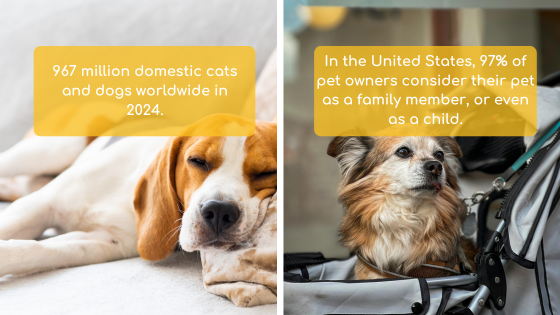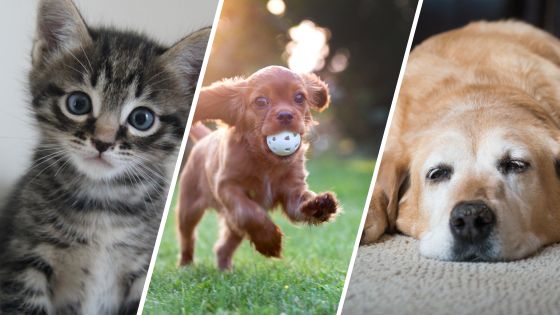
From the Humanisation of Animals to the Premiumisation of Pet Food
On April 8th, France’s “Ageing Well” law celebrates its first anniversary. This law, which seeks to address isolation and loss of autonomy among seniors, includes provisions for allowing pets into nursing homes. This law reflects the importance that a pet can have in an individual’s life. These affectionate and comforting creatures form part of many households. In 2024, there were 967 million domestic cats and dogs worldwide, representing a 2% increase compared to 2023.[1] This growth translates into an expanding pet food market, estimated at $380 billion at the beginning of 2025, and expected to reach $500 billion by 2030.[2] This evolution is a consequence of the humanisation of animals.
Pet Food: A Market Driven by the Humanisation of Animals
The Evolution of Owners’ Expectations
The pet food market is not only growing but also being transformed to meet the expectations of new generations of pet owners. Indeed, 72% of owners are Gen Z or millennials, with new priorities: they are witnessing the development of new health solutions, with the popularisation of dietary supplements, functional nutrition, personalised nutrition, etc.[3] This desire to take care of their health extends to their pets.
In the United States, 97% of pet owners consider their pet as a family member, or even as a child (referred to as “pet parenting”).[1]

Across the Pacific Ocean in East Asia, the same growing importance of pets is observed. In China, young people place less importance on marriage and children than previous generations, preferring to adopt pets, which are less costly in terms of time and money. Consequently, at the end of 2024, China accounted for a record 124 million domestic animals. According to estimates, by 2030, the number of dogs and cats will be twice as high as the number of children under the age of four.[4] This is a reversal of the situation, as in 2017, there were 90 million children in that age group compared to 40 million pets.[5] As a result, the number of births halved between 2016 and 2022, and pets are pampered and taken for walks in strollers.[6,4]
Are you interested in what’s happening in China ?
Humanisation at the Root of This Evolution
The fertility rate is not only decreasing in China; it is a phenomenon observed worldwide, where it has halved over the past 50 years,[7] while the number of domestic animals has increased. Owners are humanising their pets and seeking the best solutions for their well-being. Just as human nutrition is evolving towards health-focused nutrition with benefits, 38% of owners are looking for similar solutions for their pets.[3]
As a result, they transpose their lifestyle and consumption habits to their pets, from adopting a vegetarian diet to consuming dietary supplements. Moreover, 50% of pet food is distributed through supermarkets, making it the main and preferred place of purchase for households.[8]
Human Trends Transposed to Pet Food
Greater Health Expectations
Pet owners are looking for specific health benefits to meet their pet’s needs. They choose products with key promises: immunity, digestive health, balanced nutrition, hydration, and improved mental health. The overall well-being, both physical and mental, of the animal is increasingly highlighted.[3]

Premiumisation and Personalisation of Products
This humanisation of animals compels owners to seek high-quality raw materials, similar to those used in human food. This results in a premium food offering, the search for health-beneficial ingredients, and the integration of functional ingredients such as probiotics and prebiotics for specific health benefits (digestive health, skin, coat, bones, joints, etc.).
Gourmet and artisanal products, adapted to seasons and annual holidays, as well as plant-based products, particularly those made from insect meal, are gaining popularity. To go even further, personalised nutrition, which has recently emerged for humans, is already being extended to animals. Products take into account the breed, age, needs, and health status of the animal.
This new mode of feeding aims to improve and extend the lifespan of animals, and by extension, reduce healthcare costs.
Would you like to know more about personalised nutrition?
The Role of Dairy Ingredients in Pet Food
Properties and Benefits of Dairy Ingredients
Dairy ingredients are an excellent source of high-quality proteins and essential amino acids. They are also rich in calcium and minerals (phosphorus, magnesium, potassium, etc.), and possess probiotic properties. These ingredients thus contribute to the growth, health, and overall vitality of animals. In addition, milk powder and whey powder help improve the taste and texture of pet food, leading to better palatability and easier feeding.

Specific Applications by Age
Milk powder, easily absorbed and digested by the body, serves as an energy source for young animals whose digestive systems are still underdeveloped. It can be used to enrich milk substitutes, kibble, treats, and dietary supplements.
For adult animals, whey, which adds a sweet taste without adding lactose (not digested by dogs), is an interesting ingredient to make pet food more appetising. It can also be added to products for senior animals to support joints, the immune system, muscles, and digestive health.
Lactalis Ingredients Solutions
At Lactalis Ingredients, we offer a demineralised whey powder called Laktodem® , which is a source of proteins and lactose. It enriches preparations while limiting mineral intake, which is beneficial for products intended for young animals. We have also developed a high-quality protein, Pronativ® Native Whey Protein, which provides amino acids necessary for muscle function. Native proteins and Pronativ® native micellar caseins enrich preparations with proteins while offering superior nutritional benefits due to their unique amino acid composition.
A question ? Contact us !
Sources:
[1] Symrise, Capital Market Day, 2024
[2] Bloomberg Intelligences’s (BI), Global pet Economy 2024 Report, 2024
[3] Euromonitor International, Exploring opportunities in pet health and wellness through the lens of need states, 2024
[4] France info, “Mes chiens me suffisent” : de plus en plus de Chinois adoptent des animaux plutôt que de faire des enfants, 2025
[5] GEO, En Chine, les animaux de compagnie seront bientôt plus nombreux que les enfants, 2024
[6] National Geographic, Chine : le déclin démographique, 2024
[7] INED, Mapping the massive global fertility decline over the last 20 years, 2024
[8] Xerfi, l’alimentation pour animaux de compagnie, 2024















